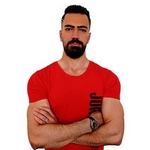Creatine is one of the most proven supplements for strength and muscle growth — but what if you’re vegan?
Plant-based diets offer health benefits, yet when it comes to creatine, the gap between vegan food sources and creatine monohydrate supplements is huge.
In this article, I’ll share my personal experience, real client stories, and science-backed insights to reveal which option truly delivers results.
Table of contents
- Which One Works Best?
- What Is Creatine and Why It Matters for Muscle Performance
- Vegan-Friendly Sources of Creatine
- Creatine Monohydrate Supplement – How It Works
- Effectiveness Comparison: Vegan Sources vs. Monohydrate
- Convenience, Cost, and Practicality
- Safety and Side Effects
- Final Takeaway – Best Choice for Athletes and Bodybuilders
Which One Works Best?
If you’re serious about strength, recovery, and muscle growth, creatine monohydrate wins hands down over vegan dietary sources.
While some plant-based foods contain tiny amounts of creatine, the difference in results is dramatic when compared to supplementing.
As a fitness trainer who’s coached vegan and non-vegan athletes for years — and as someone who’s personally tested both approaches — I can tell you that creatine monohydrate is one of the simplest and most effective tools you can add to your training arsenal.
For a deeper look at how creatine stacks up against other supplements, check out BCAA vs. Creatine – Which is Better for Strength & Size?
What Is Creatine and Why It Matters for Muscle Performance

Creatine is a compound stored in your muscles and used for quick bursts of energy, especially during heavy lifting or high-intensity exercise.
More creatine in your muscles means more explosive power, more reps, and faster recovery. Without enough of it, you’re leaving gains on the table.
Endurance athletes can also benefit — see Creatine for Runners & Endurance Athletes for more details.
Vegan-Friendly Sources of Creatine
Vegan sources include foods like quinoa, pumpkin seeds, walnuts, and some legumes.
But here’s the catch — their creatine content is so small that you’d have to eat huge amounts just to get what a simple 5 g scoop of creatine monohydrate provides.
I’ve tried structuring my meals around these foods during a plant-based phase in 2020. After six weeks without supplementation, my strength stalled. My bench press stayed stuck, and I noticed slower recovery between sessions.
Creatine Monohydrate Supplement – How It Works

Creatine monohydrate is pure, concentrated creatine. It’s one of the most researched sports supplements in the world — and for good reason — it works.
By taking just 5 g daily, you can fully saturate your muscle creatine stores within a few weeks. Once saturated, your muscles can produce more ATP (energy) during training.
This extra energy leads to better performance and faster progress. If you want to know whether you should combine it with protein, read Creatine with Protein Shake or Separate?
When I reintroduced monohydrate after my vegan-only phase, my bench press increased by 5 kg in three weeks. That’s how quickly it can make a difference.
Effectiveness Comparison: Vegan Sources vs. Monohydrate
From my own experience and coaching perspective, the performance gap is massive.
One vegan client of mine, Liam from the UK, had been stuck at a 140 kg deadlift for months. His training, recovery, and nutrition were all on point.
Once he started taking 5 g of creatine monohydrate daily, his deadlift climbed to 150 kg within two months. Without the supplement, he simply couldn’t get enough creatine from food alone.
If you’re wondering whether a loading phase matters, here’s a guide: Creatine Loading vs. No Loading – Which Works Best?
Convenience, Cost, and Practicality

Vegan foods that contain creatine are healthy, but hitting optimal levels through diet alone is almost impossible without eating huge quantities.
Creatine monohydrate, on the other hand, is cheap, widely available, and easy to take.
You can mix it in water, a protein shake, or even sprinkle it over your post-workout smoothie. And if you train before eating, you can pair it with EAAs — here’s how: EAAs + Creatine Pre-Workout Combo Guide
Safety and Side Effects
Creatine monohydrate is safe for most people. I’ve been taking it for over seven years without any negative side effects.
Most of my clients report the same. Occasionally, someone experiences mild bloating during the first week, like my client Isabella from Spain.
In her case, drinking more water solved the problem quickly. Creatine is not banned in sports — read why in Creatine Monohydrate & Banned Sports Regulations.
For hormone-related questions, see Creatine Monohydrate & Testosterone – The Full Guide
Final Takeaway – Best Choice for Athletes and Bodybuilders

If you’re vegan and want the performance, recovery, and muscle gains that creatine offers, supplementation is the most effective way to get there.
It’s affordable, easy to use, and delivers consistent results — provided you take it daily.
One of my clients, Marco from Italy, used to only take creatine on workout days. Once he switched to daily dosing, his progress accelerated, and his recovery improved noticeably.
My advice? Be consistent, train hard, and let creatine monohydrate do its job.
For vegan athletes, it’s not a question of “if” you should supplement — it’s “when you’ll start and how soon you’ll see the benefits.”
If your goal is to perform at your best, the choice is clear.



Leave a Reply